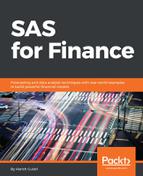Let's now discuss plotting the survival curve.
PROC LIFETEST has been used to analyze the survival plot and observe the percentage of the population that has censored data. The procedure produces a graph of the Kaplan-Meier estimator of the survival function.
Here is the code for a non-parametric procedure survival chart:
PROC LIFETEST Data=Survival_Analysis Plots=survival; Time tenure*censor(1); Run;
The CDF plot in Figure 6.5 is quite similar to the survival plot in Figure 6.7. The survival function, S(t) is derived after subtraction of the CDF from 1:
S(t) = 1 - CDF

The survival function states the probability of survival past time t. In the case of the brokerage firm's clients, the survival probability reduces sharply at the 6th and the 15th client anniversaries. There is only a 75% chance of a client surviving after the 6th anniversary. This reduces down to 66% after the 9th anniversary but continues to be around 60% till the 14th anniversary. Only after this point, at the fifteenth anniversary, does the survival probability again decrease significantly and becomes 43%.
Clients have a 31% chance of still being there with the brokerage firm after the 21st year. The survival rate table has been created by modifying the output dataset that can be saved as part of the PROC LIFETEST analysis. To save an output dataset, use the outs option. You can also view the lower and the upper confidence limits of the survival time.
Out of the 300 clients included in the study, 131 have churned, whereas 169 are active clients.
